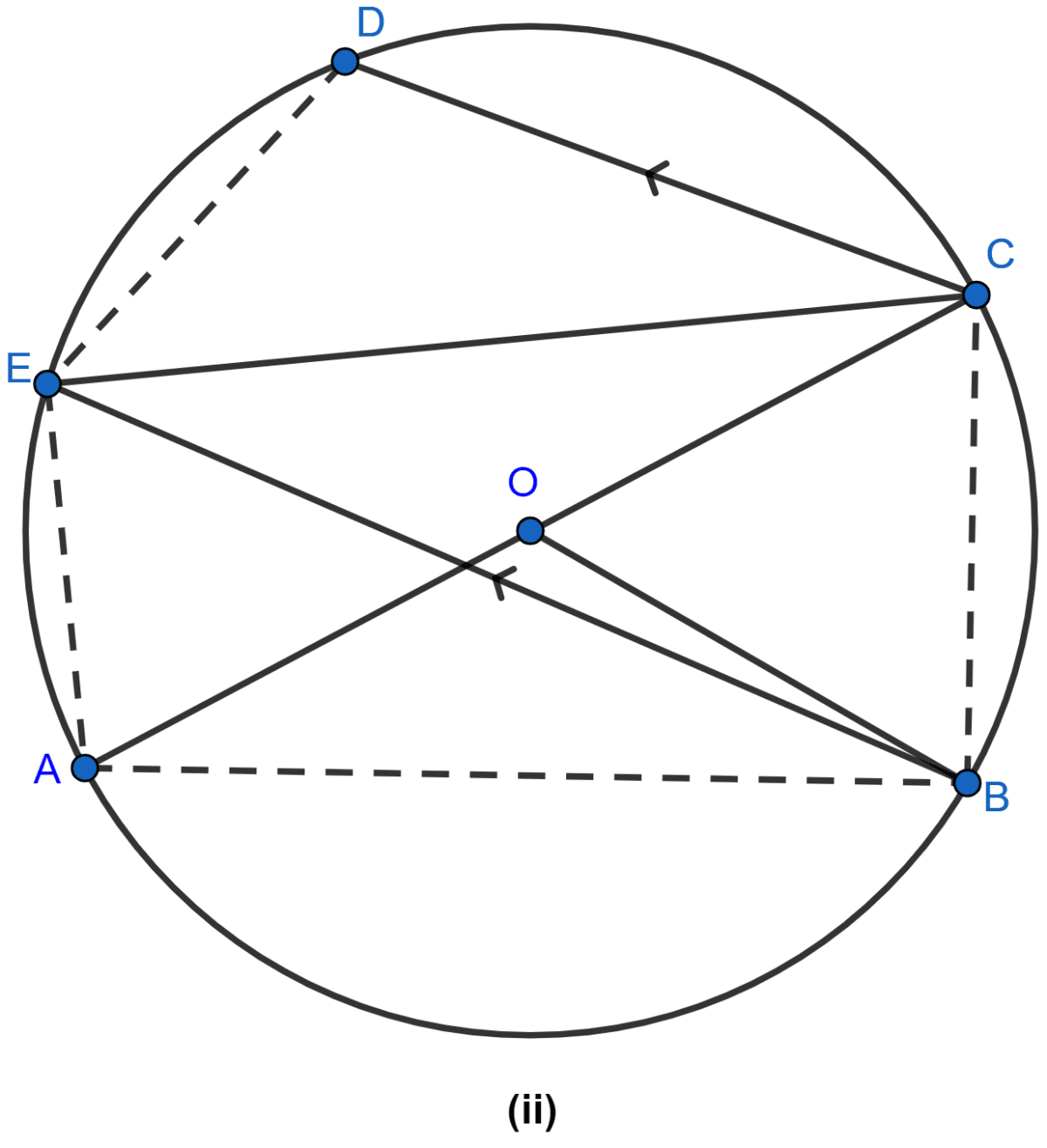Mathematics
In the figure (i) given below, chords AB, BC and CD of a circle with center O are equal. If ∠BCD = 120°, find
(i) ∠BDC
(ii) ∠BEC
(iii) ∠AEB
(iv) ∠AOB.
Hence, prove that △OAB is equilateral.

Circles
11 Likes
Answer
(i) In △BCD, BC = CD
∴ ∠CBD = ∠BDC (As angles opposite to equal sides are equal.)
Since sum of angles in a triangle = 180°.
In △BCD,
∠BCD + ∠CBD + ∠CDB = 180°
⇒ 120° + ∠CBD + ∠CBD = 180°
⇒ 120° + 2∠CBD = 180°
⇒ 2∠CBD = 180° - 120°
⇒ ∠CBD = = 30°.
As ∠CBD = ∠BDC,
∴ ∠BDC = 30°.
Hence, the value of ∠BDC = 30°.
(ii) From figure,
∠BDC = ∠BEC (Angles in same segment are equal.)
∴ ∠BEC = 30°
Hence, the value of ∠BEC = 30°.
(iii) Given AB = CB
∴ ∠BEC = ∠AEB (Equal chords subtend equal angles.)
∴ ∠AEB = 30°
Hence, the value of ∠AEB = 30°.
(iv) Arc AB subtends ∠AOB at the centre and ∠AEB at the remaining part of the circle.
⇒ ∠AOB = 2∠AEB (As angle subtended on centre is twice the angle subtended on the remaining part of the circle).
⇒ ∠AOB = 2 × 30°
⇒ ∠AOB = 60°.
Hence, the value of ∠AOB = 60°.
Since, OB = OA (Radius of same circle)
∴ ∠OBA = ∠OAB = x (let) (As angles opposite to equal sides are equal)
In △OAB,
⇒ ∠OBA + ∠OAB + ∠AOB = 180°
⇒ x + x + 60° = 180°
⇒ 2x = 180° - 60°
⇒ 2x = 120°
⇒ x = = 60°.
∠OBA = ∠OAB = 60°.
Since,
∠AOB = ∠OBA = ∠OAB = 60°
As, each angle of equilateral triangle = 60°.
Hence, proved that OAB is an equilateral triangle.
Answered By
5 Likes
Related Questions
In the figure (i) given below, ∠CBP = 40°, ∠CPB = q° and ∠DAB = p°. Obtain an equation connecting p and q. If AC and BD meet at Q so that ∠AQD = 2q° and the points C, P, B and Q are concyclic, find the values of p and q.

In the figure (ii) given below, AC is a diameter of the circle with centre O. If CD || BE, ∠AOB = 130° and ∠ACE = 20°, find :
(i) ∠BEC
(ii) ∠ACB
(iii) ∠BCD
(iv) ∠CED.

In the figure (i) given below, AB and XY are diameters of a circle with centre O. If ∠APX = 30°, find
(i) ∠AOX
(ii) ∠APY
(iii) ∠BPY
(iv) ∠OAX.

In the figure (ii) given below, AP and BP are tangents to the circle with centre O. If ∠CBP = 25° and ∠CAP = 40°, find
(i) ∠ADB
(ii) ∠AOB
(iii) ∠ACB
(iv) ∠APB.
